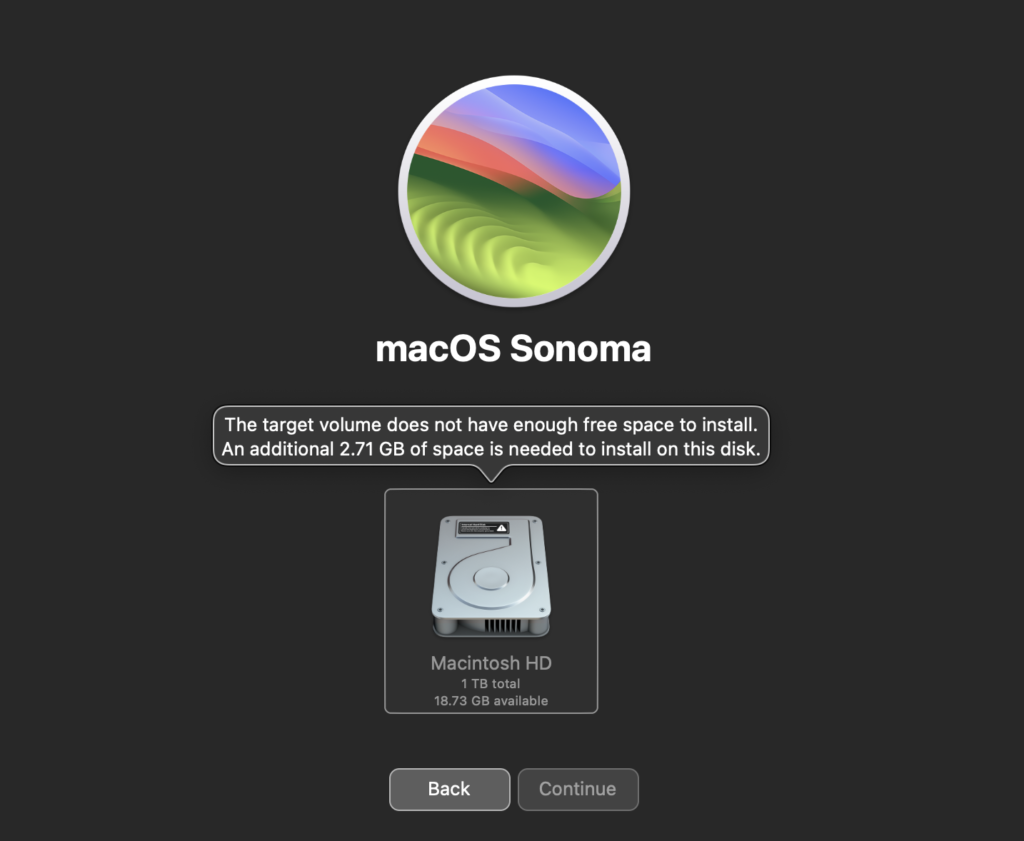Are you excited to upgrade to macOS Sonoma but stuck with the dreaded “Not enough space” message?
You’re not alone. Many users find themselves in a bind when they’re ready to install the latest macOS update, only to be halted by insufficient storage space. But don’t worry, there’s no need to give up on Sonoma just yet.
The error message reads “The target volume does not have enough free space to install. An additional (_) GB of space is needed to install on this disk.”
In this blog post, we’ll walk you through several effective strategies to free up the necessary space on your Mac and get you up and running with macOS Sonoma.
How To Fix Not Enough Space To Install MacOS Sonoma?

To fix not enough space to install macOS Sonoma, you can empty your downloads folder, remove system junk, and delete iPhone and iPad backup. Additionally, you can uninstall unused applications, and move large and old files.
1. Empty Your Downloads Folder
The Downloads folder often accumulates large files that you might have forgotten about, taking up precious space needed for macOS Sonoma’s installation.
Clearing out this folder can free up a significant amount of storage, allowing the update to proceed.
- Open Finder and select the Downloads folder.

- Review the contents and move any important files to another location.
- Select the remaining items you don’t need and drag them to the Trash.
- Empty the Trash to permanently delete the files and free up space.
2. Remove System Junk
System junk includes cache files, logs, and other temporary files that macOS creates during operation.
Over time, these can add up and consume space that could be used for the macOS Sonoma update.
- Download a reputable system cleaner tool designed for Mac or use a built-in tool if available.
- Run the tool to scan for system junk files.
- Review the scan results and select the types of junk files you want to remove.
- Confirm the deletion to clean up space on your Mac.
3. Delete IPhone And IPad Backups
Old device backups stored on your Mac can take up a lot of space. Removing these, especially if they’re outdated, can free up enough space to install macOS Sonoma.
- Open iTunes or Finder (depending on your macOS version).
- Go to the “Devices” section under Preferences.
- Look for old iPhone or iPad backups.
- Select the backups you no longer need and click “Delete Backup.”
4. Uninstall Unused Applications
Applications that you no longer use can take up a considerable amount of space. Uninstalling them can provide you with the necessary space for macOS Sonoma.
- Open the Finder and navigate to the Applications folder.
- Identify any applications you no longer use.
- Drag the application icons to the Trash or use an uninstaller if the app comes with one.

- Empty the Trash to complete the uninstallation process.
5. Move Large And Old Files
Large files such as videos, high-resolution images, and old documents can be moved to an external hard drive or cloud storage to make space for the macOS Sonoma installation.
- Open Finder and use the search function to find files larger than 1 GB (or a size you deem large).
- Sort the results by size and review the files.
- Move large files that you don’t frequently access to an external hard drive or upload them to cloud storage.
- Verify that the files are safely backed up before deleting them from your Mac.
6. Clean Up Your Photo Library
Photos and videos can use a significant amount of disk space. By cleaning up duplicates and unwanted media, you can reclaim space for the macOS Sonoma installation.
- Open the Photos app on your Mac.

- Look for duplicate photos or videos and any blurry or unwanted images.
- Delete these items or move them to an external drive or cloud service.
- If you use iCloud Photo Library, ensure it’s set to optimize Mac storage.
7. Optimize Storage With Built-in Tools
macOS includes built-in tools to help manage and optimize your storage, making it easier to free up space for system updates like macOS Sonoma.
- Click on the Apple menu and select “About This Mac.”
- Go to the “Storage” tab and click “Manage.”

- Explore the recommendations for optimizing storage, such as “Store in iCloud,” “Optimize Storage,” “Empty Trash Automatically,” and “Reduce Clutter.”
- Follow the prompts to implement these recommendations and free up space.
8. Manage Time Machine Backups
Managing Time Machine backups is crucial because these can occupy a lot of storage space, which is needed for the macOS Sonoma upgrade.
By carefully deleting old backups or snapshots, you can reclaim space on your Mac.
- Click on the Apple menu and select “System Preferences.”
- Choose “Time Machine” and click on “Options.”

- Review the list of items being backed up and remove any files or folders that don’t need to be included.
- To delete old backups manually, open Time Machine, navigate through the backups, and delete the ones you no longer need.
